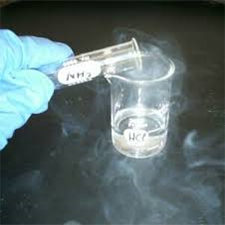Page content
- Storing hazardous substances at the workplace
- Occupational health examination
- Working with common substances:
- Excretion products and medicinal products
- Dilute NaOH Solution is Corrosive
- Add hazardous substance to water, not the other way around
- Do not mix cleaning agents
- Highly flammable alcohol
- Disinfecting with ethanol
- Limit value and vapor pressure determine solvent hazard
Storing hazardous substances at the workplace
You can keep a work stock at your workplace, but not large quantities. The regulations (PGS 15) maintain a maximum of 25 kg or litres of hazardous substances per room. For very dangerous or highly flammable substances, this is even much less: 1 litre or kilogram. As a rule of thumb, for flammable liquids in processing or as waste, keep 1 litres per m2 of floor area. If you exceed this amount, storage in a ventilated safety cabinet is necessary. In any case, always use the smallest possible volume for the work stock.
Occupational health examination
In principle, a Periodic Occupational Health Examination (PAGO) is offered to you when you start working with hazardous substances for the first time and when the risk inventory has shown that you are also exposed to these health-harmful substances (such as analysts who carry out TB cultures). You can also apply for a PAGO yourself if you or a colleague have a condition that could be the result of working with hazardous substances.
The data from an occupational health examination are registered in your personal medical file. The data is stored for up to forty years after exposure to hazardous substances has ended.
Excretion products and medicinal products
The excretion products (sweat, vomit, urine and faeces) of patients who have been treated with, for example, cytostatics or radiopharmaceuticals, are contaminated during the risk period and are classified as 'hazardous substances'. Handle this with care to minimize the risk of exposure. More information can be found under Cytostatics and Working safely with medicines.
Dilute NaOH Solution is Corrosive

Sodium hydroxide is dangerous at more than 2% concentration. Then the solution is caustic. The packaging has the pictogram 'corrosive' and the H-phrase H314 'causes serious burns and eye damage'.
Add hazardous substance to water, not the other way around

Add a hazardous substance to water and not the other way around. Make sure there is enough water and add the concentrate, in small quantities at a time.
Do not mix cleaning agents
Mixing different detergents can lead to very undesirable reactions. In industrial processes concentrated and powerful agents are used whose components are not always fully known.
Highly flammable alcohol

Pure alcohol or ethanol is very flammable. It is given the pictogram for flammable liquids and the risk phrase H225.
Alcohol 70% is a solution in water with a flash point of 21 °C. The substance therefore falls into the category of flammable with the risk phrase H225.
Ethanol is on the Dutch list of substances that are toxic to reproduction. This assessment is based on exposure to alcohol from consumption. In occupational situations, inhalation and skin absorption are more relevant. No concentrations are expected at which these reprotoxic properties occur. The European Working Conditions regulations have therefore not given alcohol a separate hazard pictogram or H phrase for reproductive toxicity. According to European regulations, the reprotoxic property does not have to be taken into account when disposing of ethanol as waste.
Disinfecting with ethanol
If you are going to disinfect with ethanol, proceed as follows:
- Wear gloves to prevent absorption of ethanol through the skin. The gloves also prevent degreasing of the skin. In healthcare, a lot of hand alcohol is used for hand disinfection. A skin care component has been added to hand alcohol to reduce the degreasing effect.
- Using a bottle or spray bottle with a pressure relief valve, apply ethanol to a tissue (or an alternative carrier).
- Wipe the surface to be disinfected with the tissue.
- Put the tissue in an SZA waste bin and cover it with a lid.
Never mist ethanol to disinfect. Due to the high evaporation, the disinfecting effect is much less and there is an increased risk of fire or explosion. In addition, you inhale high concentrations of alcohol. Put the alcohol on a cloth. If disinfection with a wipe is not possible, use a spray bottle with a pressure relief valve.
Watch the video: 'Exposure to alcohol during disinfection'.
Alcohol should only be used in a spray bottle with a pressure relief valve. Regular spray bottles build up pressure inside the bottle and then push the contents out through the hose, even though the spray bottle is not in use. Make sure the bottle is properly labeled.
More information:
Limit value and vapor pressure determine solvent hazard
The threshold limit value of a solvent indicates which concentration in the air is still permitted or accepted. A substance with a low limit value, such as chloroform (5 mg/m3) is more dangerous than ethanol (1000 mg/m3).
Whether the limit value is reached during work depends very much on the degree of evaporation of the solvent. In addition to the type of action, the vapor pressure (p) is decisive for this. Working with ether (with a p of 587 mbar) will cause an exceedance of the limit value (308 mg/m3) much more quickly than working with xylene with a p of 8 mbar, although it has a lower limit value (210 mg/m3).
The ratio p/limit value, the relative risk of inhalation, is a good parameter for comparing the risks of solvents. Keep in mind that misting and pouring over create the largest concentrations of solvent in the air.
